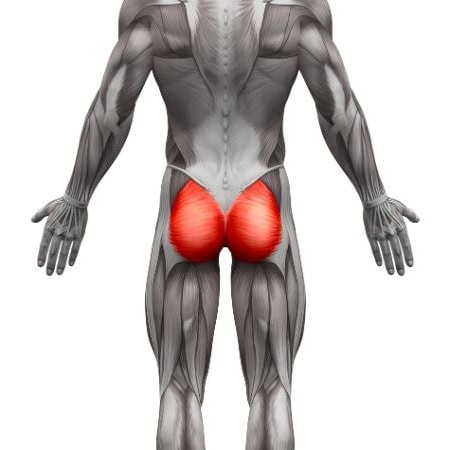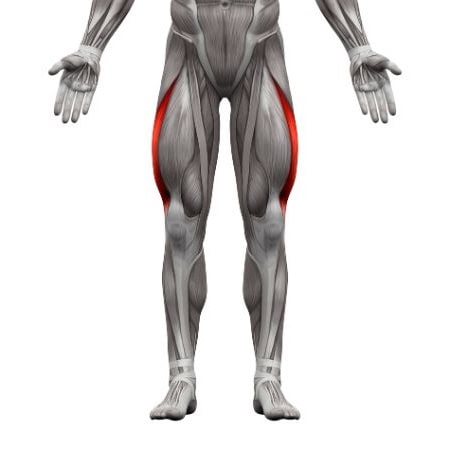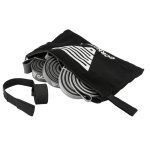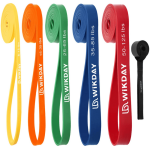Banded Front Squats
How to do Banded Front Squats?
Banded front squats are a lower-body exercise that targets the quadriceps, glutes, and core, while also working the shoulders and upper back. In this variation, a resistance band is used instead of a barbell, with the band anchored under the feet and held in front of the body, providing progressive resistance as you squat. This exercise is a great alternative to weighted squats, especially when at home or traveling, as it builds strength, stability, and functional movement patterns with minimal equipment.
Steps to Perform a Proper Banded Front Squat:
1. Set Up the Resistance Band Under Your Feet:
• Stand on the middle of the resistance band with your feet shoulder-width apart, making sure the band is securely anchored under your feet.
• Hold the ends of the band in each hand. The band should have slight tension in this position.
2. Bring the Band to Shoulder Level:
• Pull the ends of the band up to shoulder height, with your palms facing forward or slightly up.
• Hold the band in front of your shoulders with elbows pointing forward and parallel to the floor. Your upper arms should be parallel to the ground, creating a “rack” position for stability.
3. Engage Your Core and Set Your Posture:
• Keep your chest up, back straight, and shoulders down. Engage your core to stabilize your torso.
• Position your feet firmly on the ground with a slight outward angle, aligning your knees with your toes.
4. Lower into the Squat:
• Inhale as you push your hips back and bend your knees, lowering your body into a squat position.
• Keep your chest lifted and your knees tracking over your toes. Aim to lower until your thighs are parallel to the ground or as deep as your mobility allows.
5. Drive Back Up to Standing:
• Exhale as you press through your heels to stand back up, extending your hips and knees fully to return to the starting position.
• Squeeze your glutes at the top of the movement, maintaining the band tension.
6. Repeat the Movement:
• Perform the desired number of repetitions, focusing on a controlled descent and powerful drive back up.
Benefits of Banded Front Squats
• Strengthens the Lower Body: Banded front squats effectively target the quadriceps, glutes, and hamstrings, building lower-body strength and endurance.
• Improves Core Stability: The front rack position with the band challenges your core to maintain an upright posture, building core stability.
• Enhances Functional Movement Patterns: This exercise reinforces the squat pattern, improving mobility, balance, and strength needed for everyday movements.
• Portable and Accessible: With only a resistance band, this exercise is easy to perform at home, while traveling, or in small spaces without needing heavy weights.
• Reduces Joint Impact: The smooth resistance of the band reduces strain on the joints, making this exercise joint-friendly for individuals with joint sensitivities.
• Improves Upper Back and Shoulder Strength: Holding the band in front of you requires engagement from the shoulders, traps, and upper back, building upper body stability and posture.
• Engages Muscles Differently than Traditional Weights: Bands offer variable resistance, making the muscles work harder as you reach the top of the movement.
Common Mistakes to Avoid
• Allowing Knees to Cave In: Keep your knees aligned with your toes, avoiding inward collapse, which can strain the knee joint and reduce effectiveness.
• Rounding the Lower Back: Avoid rounding your lower back by keeping your core tight and your chest lifted. This helps maintain spinal alignment and reduces the risk of injury.
• Leaning Too Far Forward: Keep an upright posture, focusing on sitting back into the squat rather than leaning forward, which can shift weight off your heels and reduce muscle engagement.
• Using Momentum: Avoid using momentum to push up. Focus on controlled movements and muscle engagement, especially as you rise from the squat.
• Letting the Band Go Slack: Keep tension in the band throughout the movement by stopping just before fully straightening your legs, maximizing engagement.
Tips for the proper execution of Banded Front Squats
Engage the Core: Keep your core tight to stabilize your torso and protect your lower back.
Focus on Knee Tracking: Ensure your knees are aligned with your toes, preventing them from caving inward as you squat.
Maintain Upright Chest: Keep your chest lifted and shoulders down, which helps maintain a neutral spine and prevents rounding.
Control the Descent: Perform the downward movement slowly to engage the muscles effectively and avoid bouncing at the bottom.
Breathing: Inhale as you lower into the squat and exhale as you drive back up, maintaining stability and rhythm.
Muscles worked when doing Banded Front Squats
Primary Muscles:
•Quadriceps: The front of the thigh is heavily engaged, especially during the ascent, as it controls knee extension.
•Glutes: The gluteus maximus powers the hip extension at the top of the squat, especially as you drive up.
Secondary Muscles:
•Hamstrings: Assist in hip extension and help stabilize the lower body.
•Core: Engaged to maintain an upright posture and stabilize the spine throughout the squat.
•Upper Back and Shoulders: The trapezius, deltoids, and upper back muscles help support the band in the front rack position and maintain posture.
•Calves: Help with stability and balance in the lower body.
Primary Muscle(s):
Secondary Muscle(s):
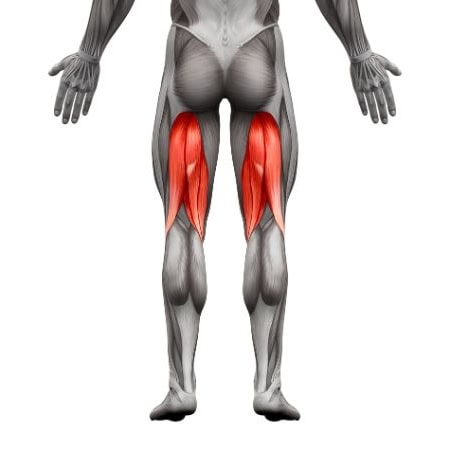
Hamstring
Adjust the difficulty of Banded Front Squats
How to make Banded Front Squats harder?
How to make Banded Front Squats easier?
How to make Banded Front Squats harder?
To make Banded Front Squats harder:
-
Use a Heavier Resistance Band: Increase the difficulty by using a band with more resistance, challenging the legs, core, and upper body.
-
Add a Hold at the Bottom: Pause for 2-3 seconds at the bottom of the squat to increase time under tension and engage the muscles further.
-
Perform More Repetitions or Sets: Add more repetitions or additional sets to increase endurance and build strength.
-
Slow Down the Descent: Take extra time to lower down into the squat, increasing muscle engagement and control during the eccentric phase.
How to make Banded Front Squats easier?
To make Banded Front Squats easier:
-
Use a Lighter Resistance Band: Start with a band that provides less resistance to make the exercise more manageable.
-
Perform Partial Squats: Lower only partway, working within a smaller range of motion until you build strength and flexibility.
-
Reduce Repetitions: Start with fewer repetitions (e.g., 8-10) and increase gradually as you become more comfortable with the movement.


